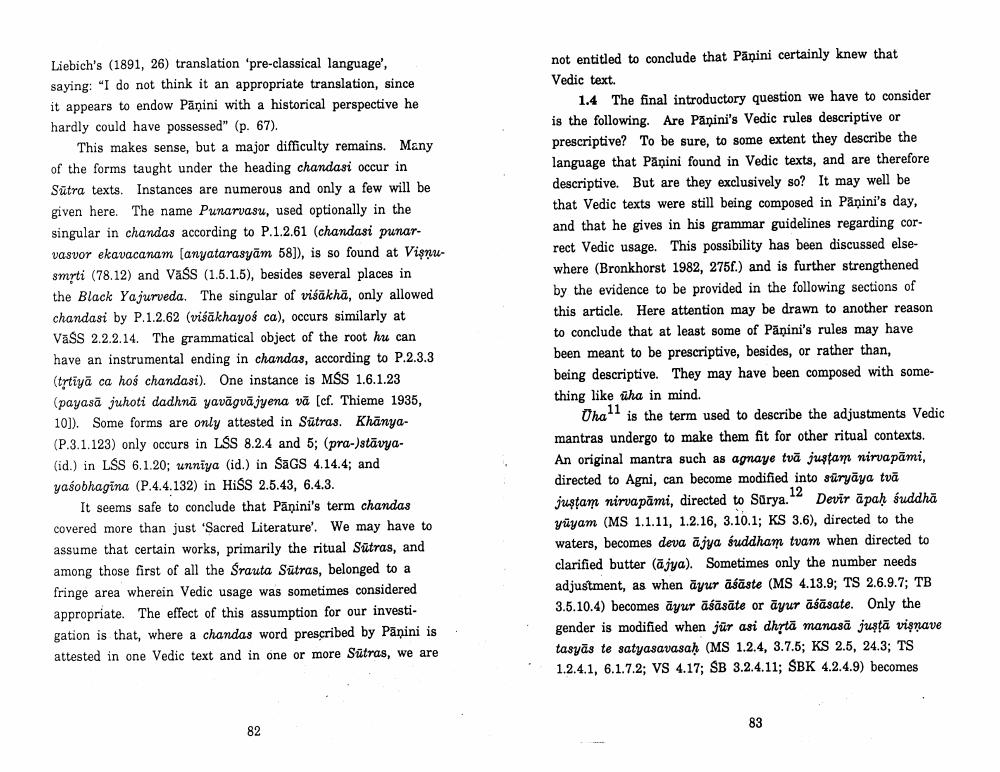Book Title: Paninian And Veda Reconsidered Author(s): Johannes Bronkhorst Publisher: Johannes Bronkhorst View full book textPage 5
________________ Liebich's (1891, 26) translation 'pre-classical language', saying: "I do not think it an appropriate translation, since it appears to endow Pāṇini with a historical perspective he hardly could have possessed" (p. 67). This makes sense, but a major difficulty remains. Many of the forms taught under the heading chandasi occur in Sutra texts. Instances are numerous and only a few will be given here. The name Punarvasu, used optionally in the singular in chandas according to P.1.2.61 (chandasi punarvasvor ekavacanam (anyatarasyām 58]), is so found at Vişnusmyti (78.12) and Vass (1.5.1.5), besides several places in the Black Yajurveda. The singular of visakha, only allowed chandasi by P.1.2.62 (viśākhayos ca), occurs similarly at VaSS 2.2.2.14. The grammatical object of the root hrs can have an instrumental ending in chandas, according to P.2.3.3 (tytiyä сa hoś chandasi). One instance is MSS 1.6.1.23 (payasa juhoti dadhnā yavägvājyena vă (cf. Thieme 1935, 10]). Some forms are only attested in Sütras. Khanya(P.3.1.123) only occurs in LSS 8.2.4 and 5; (pra-)stävya(id.) in LSS 6.1.20; unniya (id) in Sacs 4.14.4; and yaśobhagina (P.4.4.132) in HiśS 2.5.43, 6.4.3. It seems safe to conclude that Pānini's term chandas covered more than just 'Sacred Literature'. We may have to assume that certain works, primarily the ritual Sütras, and among those first of all the Srauta Sütras, belonged to a fringe area wherein Vedic usage was sometimes considered appropriate. The effect of this assumption for our investigation is that, where a chandas word prescribed by Panini is attested in one Vedic text and in one or more Sütras, we are not entitled to conclude that Pāņini certainly knew that Vedic text 1.4 The final introductory question we have to consider is the following. Are Panini's Vedic rules descriptive or prescriptive? To be sure, to some extent they describe the language that Pāņini found in Vedic texts, and are therefore descriptive. But are they exclusively so? It may well be that Vedic texts were still being composed in Panini's day, and that he gives in his grammar guidelines regarding correct Vedic usage. This possibility has been discussed elsewhere (Bronkhorst 1982, 275f.) and is further strengthened by the evidence to be provided in the following sections of this article. Here attention may be drawn to another reason to conclude that at least some of Pāṇini's rules may have been meant to be prescriptive, besides, or rather than, being descriptive. They may have been composed with something like wha in mind. Oha" is the term used to describe the adjustments Vedic mantras undergo to make them fit for other ritual contexts. An original mantra such as agnaye tvä justam nirvapāmi, directed to Agni, can become modified into süryaya tvä juştam nirvapāmi, directed to Sürya. Devir āpaḥ śuddha yüyam (MS 1.1.11, 1.2.16, 3.10.1; KS 3.6), directed to the waters, becomes deva ajya suddham tvam when directed to clarified butter (ājya). Sometimes only the number needs adjustment, as when ayur āśāste (MS 4.13.9; TS 2.6.9.7; TB 3.5.10.4) becomes āyur āśāsāte or ayur āśāsate. Only the gender is modified when jur asi dhytā manasa justā vienave tasyās te satyasavasaḥ (MS 1.2.4, 3.7.5; KS 2.5, 24.3; TS 1.2.4.1, 6.1.7.2; VS 4.17; SB 3.2.4.11; SBK 4.2.4.9) becomes 82Page Navigation
1 ... 3 4 5 6 7 8 9 10 11 12 13 14 15 16 17 18 19 20 21 22 23 24
